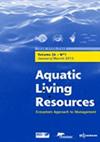Spatiotemporal structure of narrow-barred Spanish mackerel (Scomberomorus commerson) from the Red Sea and western Indian Ocean based on otolith micro-chemistry
IF 1.9
4区 农林科学
Q3 FISHERIES
引用次数: 0
Abstract
Though the narrow-barred Spanish mackerel (Scomberomorus commerson) is considered to be migratory, the species is nevertheless thought to be locally overexploited in the northwest Indian Ocean. At the regional level, this local depletion is a major concern for food security. As the population structure and connectivity between sub-populations are poorly understood for this species, we examined the spatio-temporal dynamics of narrow-barred Spanish mackerel via elemental concentrations (P, Mg, Sr and Ba) along otolith transects using LA-ICPMS for samples from 6 sites: Egypt, Djibouti North and South, Somalia, Mozambique and South Africa. For homogeneous size class samples (70–90 cm), otolith chemical signatures immediately preceding capture were used to accurately group individuals sharing a spatial proximity and/or season of capture. Notable differences in otolith edge signatures were found among individuals from north and south of the equator and contrasting cluster compositions from nearby sites in the Gulf of Aden of individuals captured in summer versus winter. Otolith core chemistry identified two spawning chemical compositions. The first common composition was characterized by relatively high concentrations of Sr and lower concentrations of P, Ba and Mg. The second less common spawning chemical composition was particularly rich in P, Ba and Mg and corresponded primarily to individuals caught off Mozambique, Somalia and Djibouti. These results are broadly consistent on one hand with patterns of water mass circulation in the Red Sea and western Indian Ocean and on the other hand with the observed spawning seasons. Though further research using, for example, archival tagging is needed to clarify the mechanisms behind these patterns, these results reveal the potential of otolith chemistry to provide insights into the spatio-temporal dynamics of narrow-barred Spanish mackerel.
基于耳石微化学的红海和西印度洋窄条纹鲅鱼的时空结构
尽管窄条纹西班牙鲭鱼(Scomberomorus commerson)被认为是候鸟,但该物种仍被认为在西北印度洋被过度捕捞。在区域一级,这种地方耗竭是粮食安全的一个主要问题。由于该物种的种群结构和亚种群之间的连性尚不清楚,我们利用LA-ICPMS对埃及、吉布提北部和南部、索马里、莫桑比克和南非6个地点的样本进行了沿耳石样带的元素浓度(P、Mg、Sr和Ba)的时空动态研究。对于均匀大小的样本(70-90 cm),在捕获之前立即使用耳石化学特征来准确分组共享空间邻近和/或捕获季节的个体。在赤道北部和南部的个体之间发现了耳石边缘特征的显着差异,并对比了亚丁湾附近地点夏季和冬季捕获的个体的群集组成。耳石核化学鉴定出两种衍生化学成分。第一种常见成分的特点是Sr的浓度相对较高,P、Ba和Mg的浓度较低。第二种不太常见的产卵化学成分尤其富含磷、钡和镁,主要适用于在莫桑比克、索马里和吉布提捕获的个体。这些结果一方面与红海和西印度洋的水团环流模式大致一致,另一方面与观察到的产卵季节一致。虽然需要进一步的研究,例如使用档案标记来澄清这些模式背后的机制,但这些结果揭示了耳石化学的潜力,可以为窄条纹西班牙鲭鱼的时空动态提供见解。
本文章由计算机程序翻译,如有差异,请以英文原文为准。
求助全文
约1分钟内获得全文
求助全文
来源期刊

Aquatic Living Resources
农林科学-海洋与淡水生物学
CiteScore
2.30
自引率
0.00%
发文量
10
审稿时长
>24 weeks
期刊介绍:
Aquatic Living Resources publishes original research papers, review articles and propective notes dealing with all exploited (i.e. fished or farmed) living resources in marine, brackish and freshwater environments.
Priority is given to ecosystem-based approaches to the study of fishery and aquaculture social-ecological systems, including biological, ecological, economic and social dimensions.
Research on the development of interdisciplinary methods and tools which can usefully support the design, implementation and evaluation of alternative management strategies for fisheries and/or aquaculture systems at different scales is particularly welcome by the journal. This includes the exploration of scenarios and strategies for the conservation of aquatic biodiversity and research relating to the development of integrated assessment approaches aimed at ensuring sustainable and high quality uses of aquatic living resources.
 求助内容:
求助内容: 应助结果提醒方式:
应助结果提醒方式:


